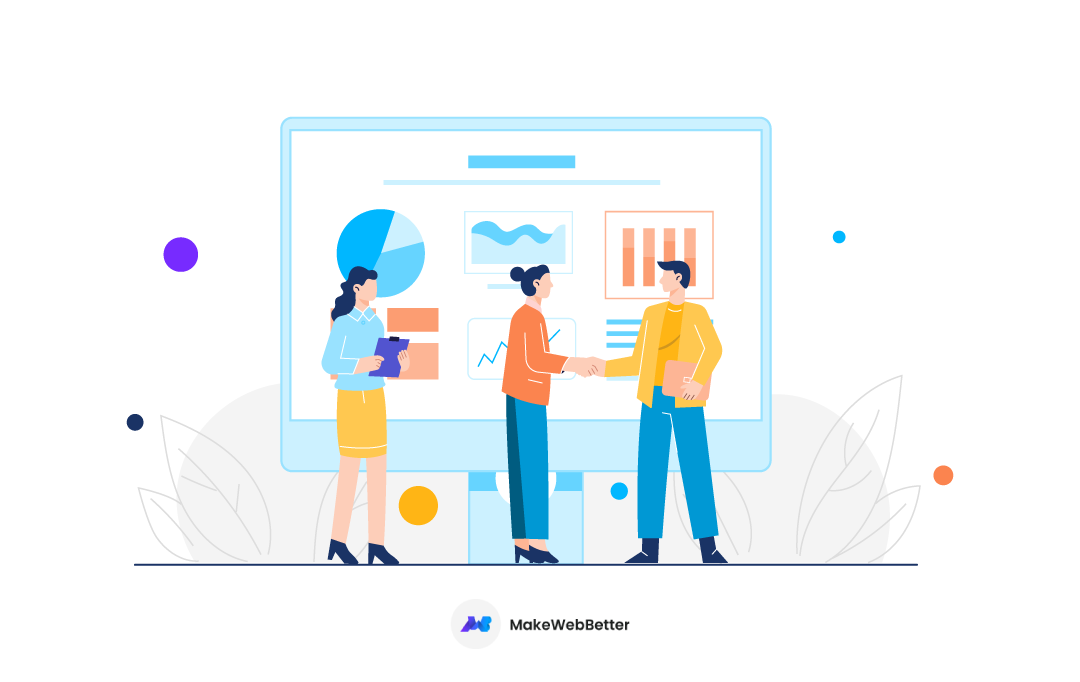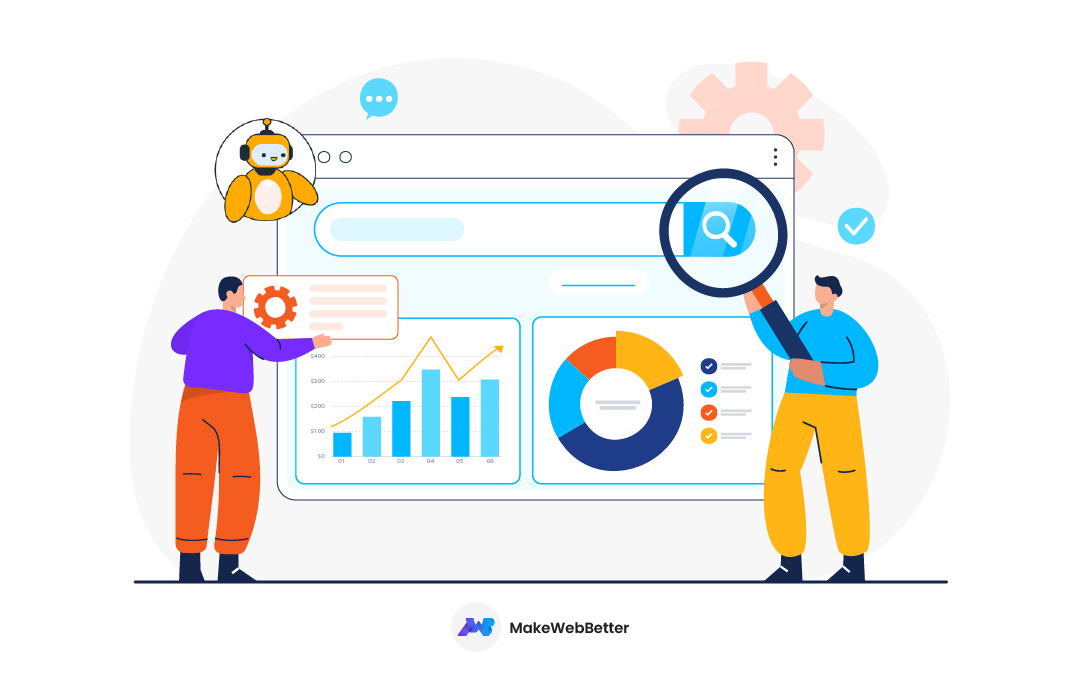CRM Stats. Yes. In this article, you will find walloping stats about customer relationship management software. If you are here to start your journey of looking for a sign to invest in a customer relationship management tool, then here it is. Read this blog thoroughly. You probably will start using a CRM after reading this article.
What Will You Discover?
What Is CRM Software?
What CRM means will never justify all that CRM can accomplish and streamline processes in your eCommerce business. Just as the name suggests, customer relationship management software nourishes customer and company relations by keeping a record of profitability, communication, sales management, and qualified leads. For example, HubSpot is an all-in-one CRM software.

Free Download HubSpot Audit Checklist
Audit your HubSpot portal the right way! DIY.
What Are The Benefits Of CRM Software?
Some major benefits of using CRM software for your eCommerce businesses are:
- Firstly, it manages, saves, and stores data of all types and multiple contacts from leads to business partners.
- Secondly, tracking customer, score lead, and prospect detail based on triggers.
- Thirdly, manage sales activities, and create targeted marketing campaigns.
- Fourthly, it creates exceptional customer experience aiding in business scaling and growth.
- Lastly, 360-degree customer engagement with third-party integrations and process automation.

Supreme CRM Stats
Here are some of the most authoritative CRM stats:
- By 2030, the global CRM size is expected to reach USD 157.6 Billion.
- 47% of users said that their CRM had a strong impact on customer satisfaction.
- CRM is among the top three tools and technologies for creating personalized interactions with customers to foster loyalty and better marketing ROI.
- The average ROI for CRM is $8.71 for every dollar spent.
- 91% of companies with more than 11 employees use a CRM system.
- 74% of companies say CRM technology gives better access to customer data.
- If a company can’t give consistent levels of service across channels, 73 percent say they’ll switch brands.
- AI-powered CRM operations would increase business revenue by $1.1 trillion.
- For 2023 and beyond, businesses will prioritize to drive better customer experiences.
CRM Usage Statistics
1. The global CRM market share will reach 157.6 Billion USD by 2030.
CRM can be a growing factor in your business. But, do you know at what pace the CRM market is growing? The global customer relationship management market was worth USD 52.4 billion in 2021, and it is expected to increase at a CAGR of 13.3% from 2022 to 2030.
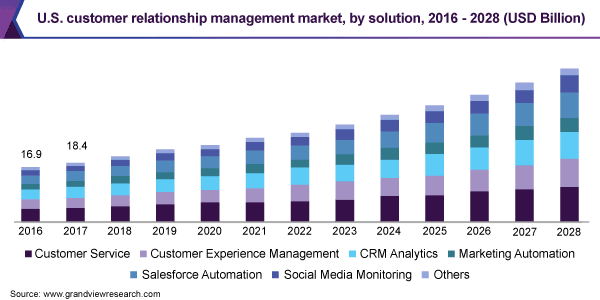
Why are we considering CRM market share?
Market share throws light on the consumers’ preference for CRM over other alternatives or similar software. A larger market share typically translates to better sales, less effort to sell more, and a high barrier to entry for new competitors.
From 2014, CRM software has recorded amplifying interest over time as seen in Google Trends.
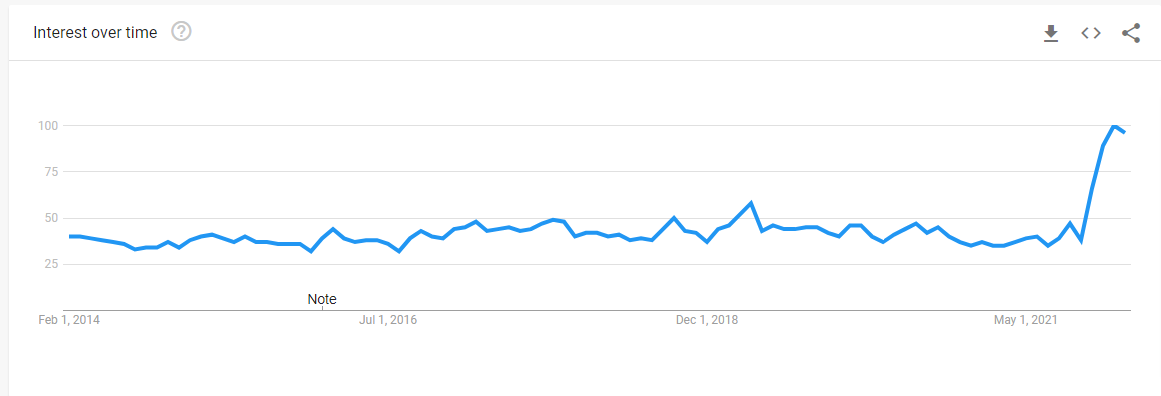 Google trend for keyword ‘CRM Software’
Google trend for keyword ‘CRM Software’
2. A CRM is used by 91% of organizations with 10 or more employees.
91% of organizations with more than 11 employees, compared to 50% of companies with less than 10 employees use CRM software. CRM is quickly becoming a must-have element in all forms of corporate technology.
According to Grandview Research’s industry estimates, more than 91 percent of organizations with 10 or more employees utilize a CRM to manage client conversations. CRM analytics is also one of the fastest-growing areas of customer experience technology.

3. Salesforce is the best CRM for growing businesses with 64582 live websites.
Take a look at Salesforce statistics. Salesforce turns out to be the leading choice for growing and small businesses. Salesforce CRM’s market share in 2020 was 19.5 percent. Presently, 64582 websites are built with Salesforce and it was ranked #1 in CRM market share for the eighth consecutive year in 2021. Over 150,000 customers and 29,000 employees worldwide are under Salesforce.
Salesforce revenue: 21.25 bn USD
Net income of Salesforce: 4bn USD

If you check other Salesforce statistics, they are highly encouraging. But, there is one reason to avoid using Salesforce. That is to say, it is typically costlier than competitors and offers no free plan. Subsequently, Microsoft and Oracle follow Salesforce in CRM market share.
Moreover, with 2.2 billion dollars in revenue in 2021, Visma was the leading SaaS CRM and related software provider. Visma is a company that develops financial and accounting software.
Best Alternative To Salesforce
HubSpot Marketing Hub Professional is the best alternative to Salesforce
4. Spending on corporate software by IT (information technology) sectors around the world from 2009 to 2023 expected 672 billion U.S.D.
Many enterprise software sub-segments have evolved into enormous markets in their own right, such as business process management (BPM) software, enterprise resource planning (ERP) software, and customer relationship management (CRM) software.
 Worldwide Cloud-Based Enterprise Applications Market Forecast 2020-2025, By Functional Market, $M
Worldwide Cloud-Based Enterprise Applications Market Forecast 2020-2025, By Functional Market, $M
CRM software analyses and improves corporate interactions with current and potential customers, and sales are predicted to reach over 47 billion dollars in 2022. Additionally, Global IT investment is estimated to reach $672 Billion in 2022, up 11% from the previous year.
5. B2C and retail sectors have the highest usability of CRM.
CRMs are highly used in vast fields. It’s hardly surprising that no single industry accounts for the bulk of CRM buyers, given that practically every firm requires some CRM solution.

However, according to Software Advice, certain industries find it more fruitful. In increasing order, they are:
- Investing in real estate
- Consulting
- Distribution
- Insurance
One major commonality in these sectors is the contact management feature of customer relationship management software.

6. Customer experience wins amid COVID 19 paving the way for CRM.
Extraordinary experiences help businesses do more than make sales. That is to say, they help form relationships. Fifty-three percent of buyers say the companies they buy from the most have an emotional connection to them. 90% of customers believe a company’s response to a crisis reflects its credibility.


Customer service is equally important as the product. Additionally, CRM offers a personalized approach towards achieving it. When client information arrives from digital sources – and sales and service workers take the time to enter it into the customer record – CRM performs an excellent job of recording it.
General CRM Stats
7. CRM growth rate is astonishing: $128.97 Billion by 2028.
The global customer relationship management (CRM) market is expected to increase at a CAGR of 12.1% from $58.04 billion in 2021 to $128.97 billion in 2028. Moreover, the global market for CRM was estimated to be worth $52.64 billion in 2020.
The pandemic’s impact in the same year pushed CRM demand dramatically. Subsequently, businesses needed a new way to communicate with customers in the digital age.
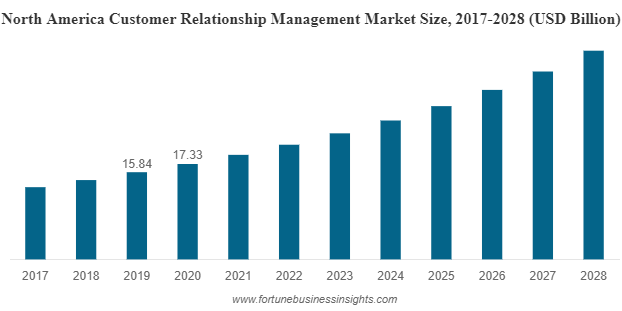
8. CRM operations powered by AI will generate $1.1 trillion in additional income for businesses.
According to the Salesforce-sponsored report, AI-powered CRM operations would increase business revenue by $1.1 trillion between 2017 and 2021 while creating more than 800,000 direct employment and 2 million indirect positions worldwide, outnumbering those lost to AI-driven automation.
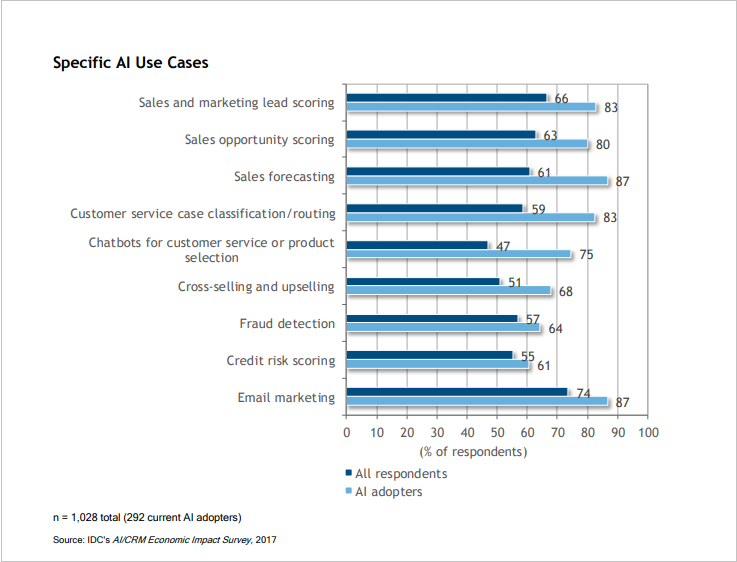
According to the report, higher productivity and lower expenses due to automation will account for $121 billion and $265 billion, respectively, of the $1.1 trillion total.
9. CRM implementations are estimated to cost $4.6 Billion per year, according to a new study.
According to recent research from ZoomInfo, organizations of all sizes will deploy over 42,000 new CRM systems, spending an estimated $4.6 billion in the process. Every quarter, over 10,000 CRM installations are completed.
Therefore, it is estimated to be 4.6 Billion per year if these installations or more happen regularly.
10. The majority of small organizations install CRM software: 71.8 percent of businesses with 1-50 employees.
According to ZoomInfo, small businesses with fewer than 100 employees would bear the brunt of CRM implementations, accounting for more than 33,000 of them. Each of these projects is $3,000 on average.
Around 71.8 percent of organizations with 1 to 50 employees actively install CRM software. While most of the enterprise businesses already use one.

Additionally, the SMBs with annual revenue of less than $1 Million are actively involved in CRM purchases. Only 20% of our buyers have a revenue of more than $5 million per year.

11. Businesses & enterprises will spend huge on CRM: IT to invest 5.1 percent more in 2022.
As businesses continue to invest in technology, one survey revealed that over half of them are increasing their expenditure on CRM, customer service, and associated technologies to stay competitive and because their sales are increasing as a result of its use.
Gartner forecasts that worldwide information technology spending will grow around 5.1% in 2022. With improvement in enterprise software spending, CRM as the most important software comes into the picture.
Additionally, 751,937 Million USD is predicted to be invested in the same by 2023. And, without a doubt, CRM reserves a huge chunk of investment.
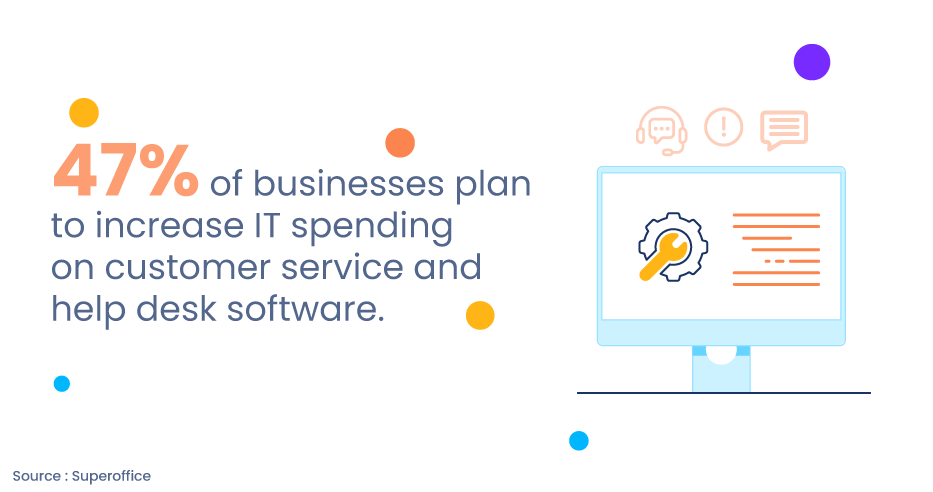
12. Covid 19 has only added to the CRM growth. CRM software market procurement intelligence report forecasts spend growth of over USD 47.41 Billion.
The Covid-19 impact seems to have had a promising effect on the CRM market. After the pandemic, the need for the CRM software market has grown up to 47.41 USD CAGR of over 13.10%.
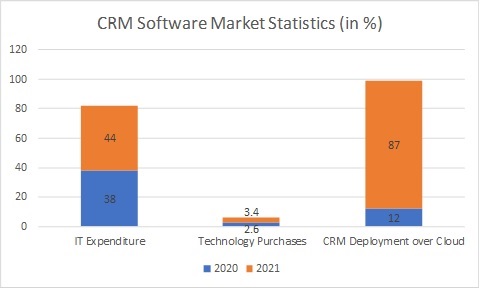 Source: marketresearchfuture
Source: marketresearchfuture
CRM Growth Stats
13. Within the first five years, most businesses invest in CRM technology.
Companies are eager to develop their client interactions as soon as feasible. Therefore, businesses usually entail investing in CRM early on, usually within the first five years of a company’s existence.
When these companies implement CRM technology, sales teams use it about 80% of the time, marketing team for 46%, and customer support at 45%.
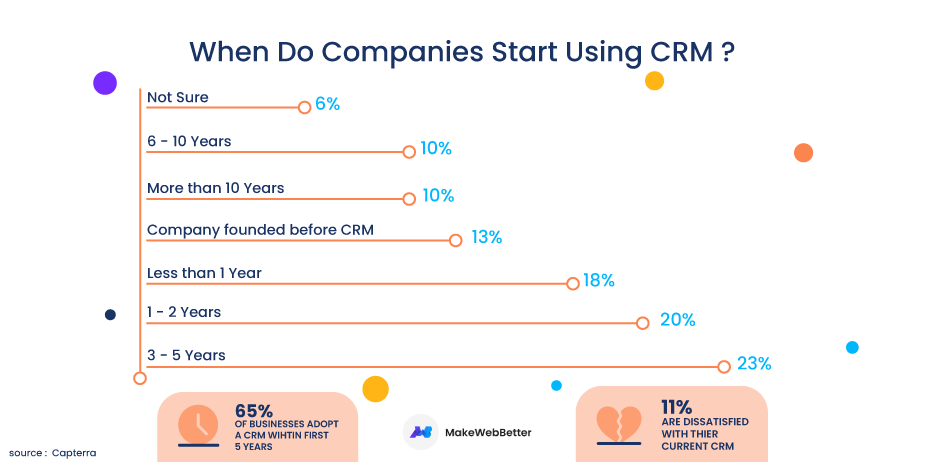
14. 88 percent of CRM buyers have focused on lead management features.
According to an analysis of over 9,000 CRM software inquiries received by Software Advice from buyers in 2019, the lead management CRM function remains the most asked one, 88 percent.
Contact management follows at 72 percent then comes to email at 48%, reporting & analytics at 41 percent, and marketing at 32 percent.

This CRM fact announces lead management as the highest priority for companies. A lead management system will streamline the sales process and assist your company in converting more leads into loyal customers—all while avoiding turmoil. CRM works to great extent for managing and filtering unqualified leads.
15. Companies use any CRM for a minimum term of 2-5 years before they decide to switch.
Two-thirds of those who responded to our study used their CRM for over a year. Most respondents have been using their CRM for roughly 2-5 years on average.
Only 4% of respondents said they’d been using their current CRM for more than ten years, indicating that staying decades on the same platform is becoming less typical as new CRM entrants arise and enterprise IT architecture improves.

According to Salesforce, if an organization cannot give consistent services across channels, 73 percent say they’ll switch brands. The same research states, 70% of customers believe that technology has made it easier than ever to transfer their business elsewhere.
Subsequently, any annoyance or unfulfilled expectation can easily result in a lost lead.
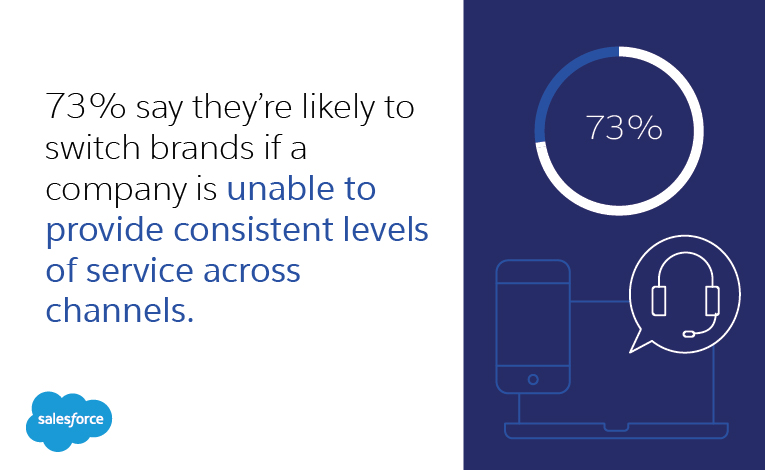
16. For every dollar invested in CRM, the average return on investment is $8.71.
According to Nucleus, for every dollar spent on CRM, a firm receives $8.71 in return – 1.5 times more than they did three years ago. Since November 2011, Nucleus has published case studies on CRM projects, including deployments from all major vendors and smaller point solutions.
The best method to boost your CRM ROI is to boost the conversion rate of your sales staff. The capacity of a company to convert a lead into a paying customer is one of the most crucial indicators. Even a 0.5 percent boost in conversion rate can result in hundreds, if not millions, of dollars in new and recurring business.
CRM does more than track information. It makes it easier for you to understand the importance of different segments of data that can later be used for maximizing your ROI based on the actions you take.
CRM Sales Stats
17. Global customer relationship management market share by application goes maximum i.e. 32% to marketing and sales automation.
If the use of customer relationship management is segmented by the application then the popular ones are customer management, lead generation, customer retention, customer support, contact centers, etc.
Worldwide businesses receive product and software inquiries that add up to the process of lead generation via CRM.

18. Customers expect higher service requirements with high engagement rates than last year.
Customers want quick, simple, and effective service, and they’ll instantly switch to your competitor if they don’t get it. More than 60% say that due to the crisis last year, they now have higher customer service requirements.
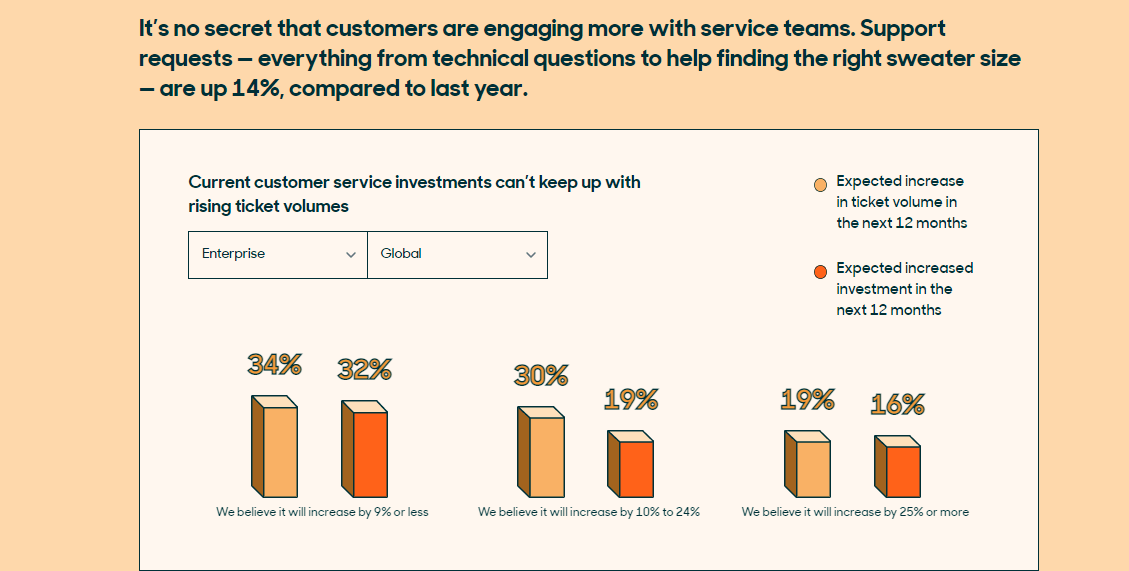 Source: Zendesk
Source: Zendesk
Customer involvement is rising 14% year over year, implying more work and more opportunities to upsell or cross-sell in ways that benefit customers.
According to 64% of business leaders polled, customer service has a favorable impact on their company’s growth. Moreover, it promotes customer retention, according to 60% of respondents.
19. Quality customer service drives higher & repetitive sales.
With 73 percent of business leaders seeing a direct correlation between customer service and corporate performance, this trend is likely to continue.
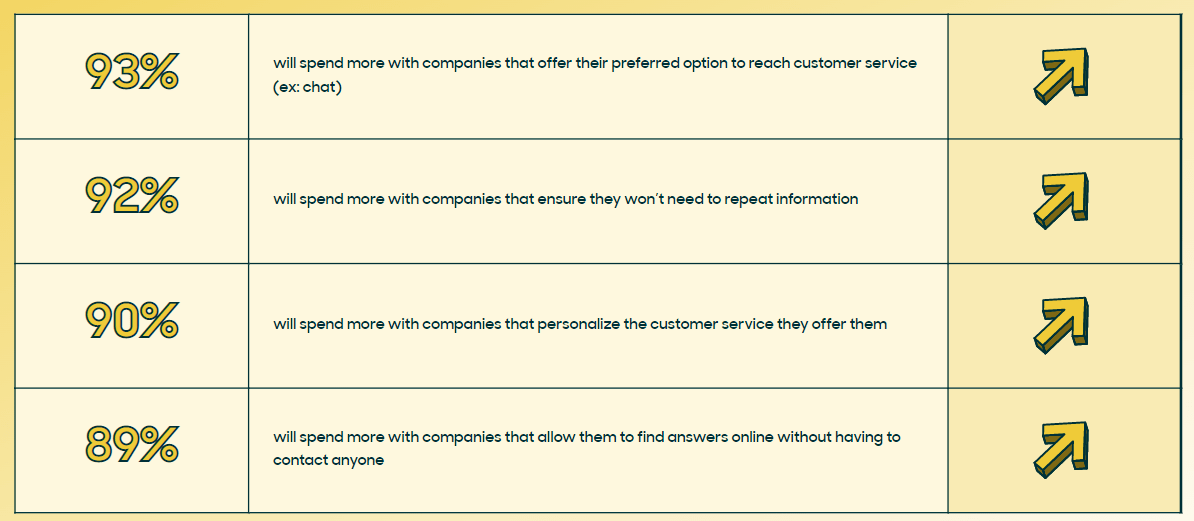 Source: Zendesk
Source: Zendesk
Customer service representatives are becoming increasingly vital in this new corporate environment. And whether a firm meets or surpasses customer expectations is frequently linked to its financial performance.
Hence, a CRM that is a complete customer service improvement tool, pulls your business out from low revenue.
20. Businesses’ priorities for 2023 and beyond are customer service-oriented. 56 percent aspire to drive better customer experiences.
Customer needs and requirements have always been the top priority of all organizations. According to the Zendesk CX report, for 2023 and beyond, businesses will prioritize: drive better customer experiences, improve efficiency, drive stronger customer relationships, increase customer satisfaction, and increase sustainability.
 Source: Zendesk
Source: Zendesk
21. 22% of salespeople have no idea about CRM software.
With so much more influence on customer reviews and service, can you imagine there are still organizations that don’t pay much attention to it?
CRM technology has yet to achieve the influence that it deserves in the industry. Around 22% of salespeople say they have no idea what a CRM is, and 40% of businesses don’t utilize one at all.
For maintaining consumer data, these businesses frequently use spreadsheets and email.
22. Approximately 82 percent of businesses utilize CRM for sales reporting.
According to a recent analysis by Grandviewresearch, 82 percent of organizations utilize their CRM systems for sales reporting and process automation.
On the other hand, senior management in firms is increasingly relying on CRM solutions to manage actionable customer data.
23. 47% of users say CRM helps achieve customer retention and satisfaction equally.
CRM is designed to help you track the return on investment of your sales and marketing efforts, but how did companies feel about their CRM investment?
Nearly half of respondents claimed that CRM had significantly increased their client retention and satisfaction rates.
Similarly, 45 percent of respondents stated their revenue increased after using a CRM, and 39 percent said the software helped them find additional upselling and cross-selling opportunities.
CRM Technology Stats
24. Marketing automation with CRM creates miracles: 79% of businesses use CRM for marketing automation
Marketing automation helps produce and nurture prospects. On the other hand, CRM generally drives and boosts sales. Moreover, a CRM platform is geared at sales reps, whereas a marketing automation system assists team members in focusing on marketing.
Consequently, the target audience is the major priority for companies. 65 percent of marketers consider their automation strategy to be very effective. Only 18 percent of sales professionals’ time is spent using their CRM system (CRM).
25. Using mobile CRM has resulted in a 50% improvement in productivity for businesses.
The CRM industry’s leaders are still more concentrated on laptop and desktop usage. But, mobile CRM expands at an 11 percent annual rate. It is approaching $15 billion globally because people spend more time on mobiles.
According to CRM market statistics, companies increased their mobile sales targets by 35 percent from 22 percent.
26. In 2020, 87 percent of businesses were seen utilizing cloud-based CRM.
According to cloud CRM data, only 12% of businesses used cloud CRM in 2008. But that number rose to 87 percent by 2020 because of CRM systems’ efficiency and cost-effectiveness.
Hence, younger businesses are also more likely to choose cloud-first solutions. The same was expected to be 75 percent in 2019 by Gartner.
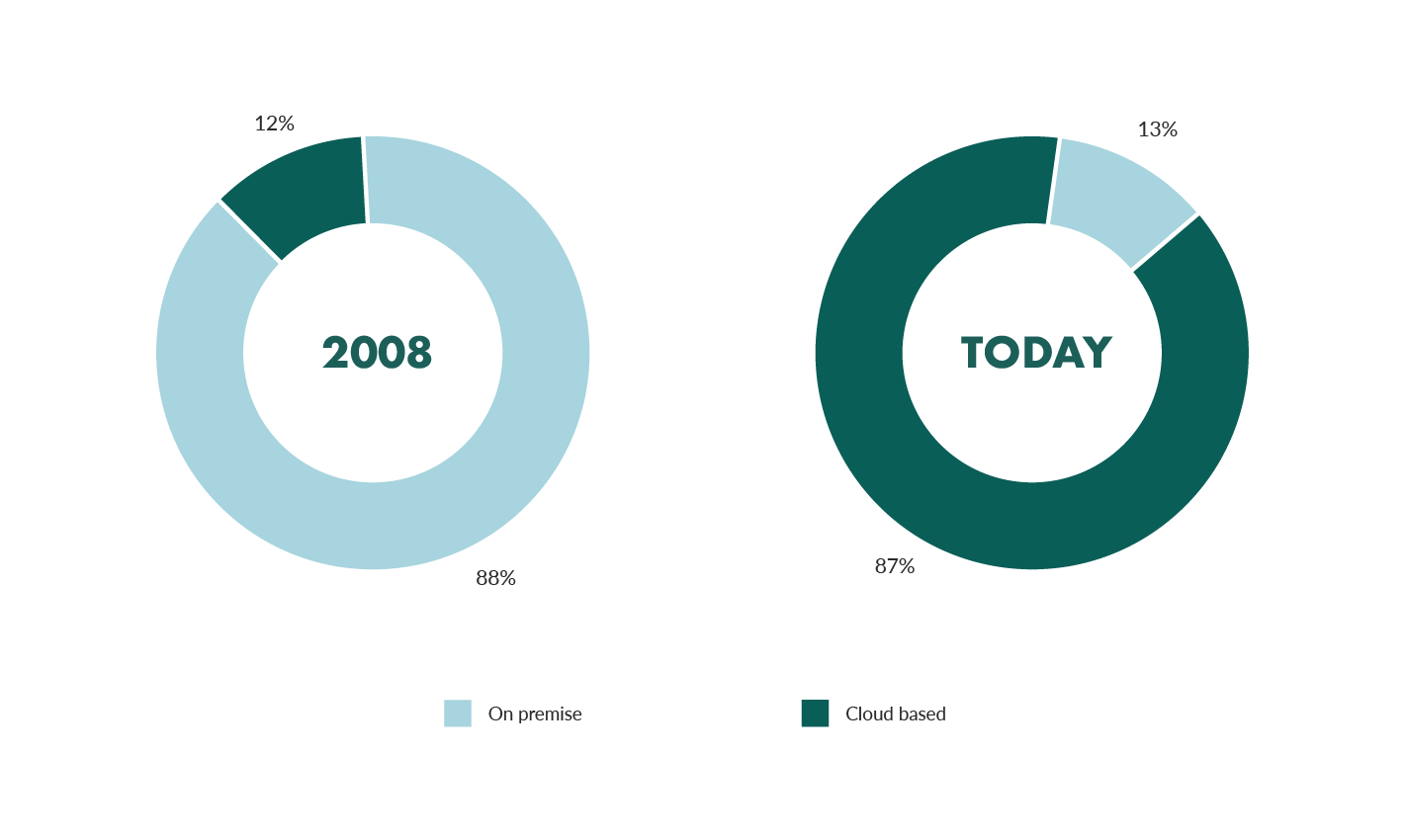
27. 700+ CRMs congest the market.
The CRM market share is huge. As a result, new CRM technologies are arising. With nearly 738 different platforms (and that’s just the number of CRM tools listed by G2), the CRM market is already congested.
However, only around 11 percent of these tools, get a perfect score. So, as helpful as CRM software is, it also should be chosen wisely.
28. Mobile and social CRM are the new platforms: Sixty-five percent of businesses using mobile CRM meet their sales targets.
CRM technology’s better data accessibility can cut the sales cycle’s complexity by 8-14 percent on average. CRM decision-makers also claim that social and mobile CRM boosts productivity by 14.6%. According to an IBM study,
- Firstly, seventy-eight percent of companies that don’t use mobile CRM fail to fulfill their targets.
- Secondly, seventy-nine percent of clients will not convert if they do not have access to a CRM.
- Thirdly, retention increases by 26% when using social CRM. Regarding customer retention, 80 percent of companies use email marketing for that.
CRM Challenges Stats
CRM is a central hub for all businesses, offering valuable features relating to sales, marketing, and customer support.
However, no software can deliver value unless it is correctly integrated and used by company employees. Here are a few CRM statistics that show its challenges:
29. Manual data entry is a major CRM challenge.
According to HubSpot, manual data entry is sales’ chief CRM complaint. In HubSpot’s 2014-2015 State of Inbound: Sales Edition report, over 20% of sales professionals reported manual data entry as their top CRM difficulty.
Additionally, other problems included a lack of connectivity with other tools and erroneous or wrong data.
According to the same survey, “ data entry time is inversely correlated with user happiness. Both practitioners and executives prefer to spend their time selling rather than doing manual tasks that software should help them avoid, especially after a resource-intensive acquisition and integration.”
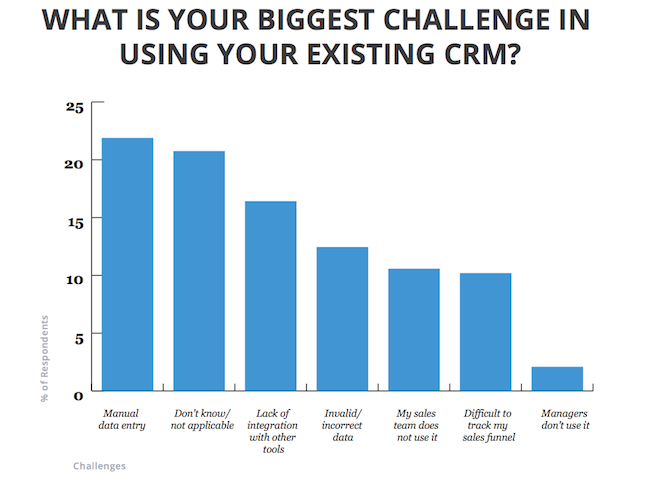
Thirty-two percent of sales reps spend more than an hour per day manually entering data. Certainly, it’s also the main reason behind CRM’s slow uptake.
30. 43 percent of sales reps don’t exploit CRM completely.
The sales representatives spent upto 2/3rd of their working hours on CRM management. Subsequently, around 43 percent of CRM avail themselves of half of the CRM’s features.
According to 13% of organizations, using sales technology in day-to-day jobs is more challenging now than it was 2–3 years ago. Moreover, almost six out of ten salespeople say they don’t modify what works for them once they figure it out.
Most importantly, the adoption of new technology, according to 22% of business owners, is the most challenging problem they face
31. The lack of third-party apps and tool integration is one of the major challenges for CRM working.
The HubSpot study found that resistance to change is cited as a barrier by 34% of SMEs without a CRM. Subsequently, for 17 percent of salespeople, the absence of CRM integration with other tools is the most challenging aspect of utilizing their current CRM.
Your Sign To Get a CRM for Your Business Now
Customer relationship management is critical for achieving corporate goals. As you must have read, the CRM adoption statistics demonstrate that companies who use CRM effectively believe that such solutions are critical to achieving their revenue goals. If you think there are some more sizzling CRM stats, shoot right in the comment box below.
Here, my duty of creating a CRM buzz in your brain is over. But wait! Yours has just begun. Subsequently, find out more about CRM, its pros and cons, types of CRM, and the best fit for your business. Or if this sounds overwhelming to you, maybe just schedule a short discussion with us. We are a certified HubSpot agency and we know everything about a CRM.

